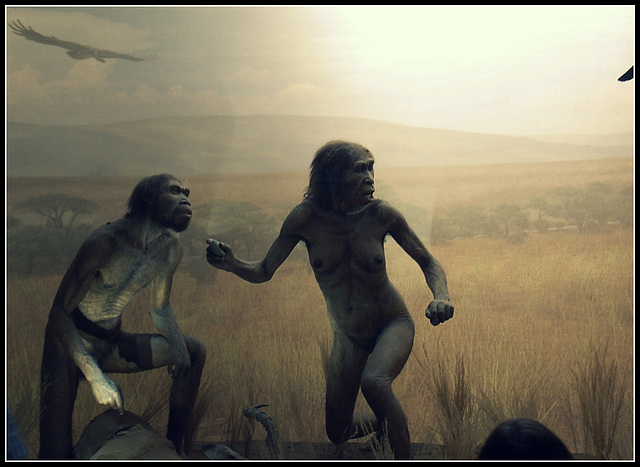See also...
Keywords
Authorizations, license
-
Visible by: Everyone -
All rights reserved
- Photo replaced on 16 Oct 2014
-
137 visits
Ancestors


We do not, of course know exactly when our ancestors lost their fur, because soft tissues and fur are almost never preserved in the fossil record. But we do know that they began to talk bipedally at a very early stage. Two sources of information confirm that for us. One is the shape of the hips and leg bones of the earliest fossil hominids. The half skeleton named Lucy that Don Johnson dug out of the Ethiopian Afar desert in 1976n has a well-preserved pelvis and associated leg-bones which clearly prove that this diminutive early hominid from 3.3 million years ago already walked upright. We can tell this from the shape of the pelvis and from the way the knee and hip joints articulate; modern humans have a bown-shaped pelvis which provides is more stable platform to brace the legs against during walking, whereas apes have a long thin pelvis designed to give more support when climbing. It is clear from the shape of her bones that Lucy’s style of walking was not yet fully human: she would have waddled somewhat, rather than walking with the balanced stride so characteristic of modern humans. Moreover, her fingers wee longer and more curved that ours and her chest and arms were more strongly built, suggesting that she was still well adapted to climbing about the trees. But when on the ground, it seems she almost certainly walked upright. ~ Page 108
- Keyboard shortcuts:
Jump to top
RSS feed- Latest comments - Subscribe to the comment feeds of this photo
- ipernity © 2007-2024
- Help & Contact
|
Club news
|
About ipernity
|
History |
ipernity Club & Prices |
Guide of good conduct
Donate | Group guidelines | Privacy policy | Terms of use | Statutes | In memoria -
Facebook
Twitter

Sign-in to write a comment.